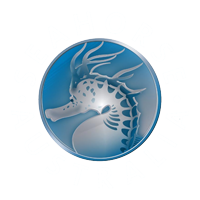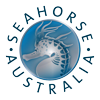Our seahorses are captive-bred and accustomed to living in an aquarium.
Like any animal they do need to be fed and their aquarium cleaned regularly.
There are many different sizes and styles of aquaria to choose from. An uncrowded aquarium will help you to observe the fascinating habits of your seahorses.
A normal fish tank with filtration system.
The minimum size should be 60 L, which will safely house four captive-bred seahorses. However, a larger tank (e.g. 150 L) will allow you flexibility in interior design, while giving the seahorses room to explore their new habitat. Deeper tanks are desirable if you intend to breed your seahorses.
The larger your tank, the easier it is to maintain optimum water quality.
Undergravel filters, canisters and external sumps with wet/dry filters are examples of different filters on the market. They have varying levels of maintenance required. We recommend you research biological filtration prior to purchasing any marine fish.
Aquarium water quality testing kits are important to ensure your water quality is safe. Ammonia, nitrite, nitrate, and pH, temperature and salinity are the most important parameters to keep watch on.
Some artificial plants or other structures should be added that provide sites for the seahorses to wrap their tails around. Live corals may be toxic to seahorses and live rock can be a source of harmful disease. Artificial decorations are a good alternative to these.
Salinity
Seahorses tolerate a range of salinity from a minimum of 18 parts per thousand (ppt) to a maximum of 36ppt. About 32ppt is ideal. In specific gravity terms, between 1.01 and 1.02. They will live in artificial seawater and commercial brands are available. DO NOT use a mixture of table salt and freshwater as this will kill your seahorses!
Preparation of artificial seawater requires care and we advise that the tap/fresh water be prepared first. The following is necessary:
- Place fresh water in storage bucket for 2 hours with aeration. Have enough water for a 50% water change.
- Check and dechlorinate carefully by adding water conditioner.
- Add commercial artificial sea salt as recommended on the pack.
In hot weather the salinity may increase. Monitor and add fresh water (with water conditioner) to reduce the salinity level. Party ice is ideal to lower the temperature and salinity.
Measuring salinity is done with an inexpensive hydrometer which is readily available from your aquarium dealer.
Temperature
Southern Knights are temperate marine fish most content between 16-20°C (60-70°F). Our kuda, barbouri, reidi varieties require 23-28°C.
In many parts of Australia, a chiller may be needed to achieve this. Other ideas to keep temperature down in warm climates:
- Keep in an air-conditioned or cool part of the house.
- A generous tank size (eg >120 L).
- 2 freezer blocks. Keep one in the tank and one in the freezer and alternate as required.
- Add party ice. These simply replace evaporation and do not severely alter salinity.
- Insulate unseen sides of tanks. (e.g. add polystyrene to sides of tanks hidden in cabinets).
Ammonia, nitrite and nitrate
A good biological filter will remove ammonia and nitrite. Remember that it will take up to 40 days to settle your filter and ensure its operation. It is important to establish this biological filter prior to stocking with your seahorses. Prepare water changes as described under salinity. The filter will be working when the water is constantly clear and ammonia is below 0.1 parts per million.
Having to find a source of live food is a thing of the past, thanks to Seahorse Australia’s ability to train Southern Knights to feed on previously frozen food. They love frozen mysid shrimp, small krill and brine shrimp. They require feeding twice per day with approximately 50 shrimp/krill.
In warmer weather (water temperatures) feed a little extra. As with all aquarium fish, any uneaten food should be siphoned away. When doing this, be careful not to injure your seahorse with the suction of the siphon.
If live diets are available from your aquarium dealer, then these can be purchased occasionally to give your seahorse a treat. They will especially love the thrill of chasing their prey.


